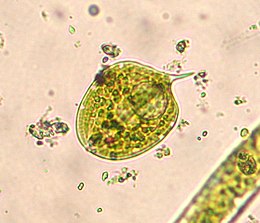| Phacus | |
|---|---|

| |
| Phacus sp. | |
| Scientific classification | |
| Domain: | Eukaryota |
| Phylum: | Euglenozoa |
| Class: | Euglenida |
| Clade: | Euglenophyceae |
| Order: | Euglenales |
| Family: | Phacaceae |
| Genus: | Phacus Dujardin, 1841 |
Phacus is a genus of unicellular excavates, of the phylum Euglenozoa (also known as Euglenophyta), characterized by its flat, leaf-shaped structure, and rigid cytoskeleton known as a pellicle. These eukaryotes are mostly green in colour, and have a single flagellum that extends the length of their body. They are morphologically very flat, rigid, leaf-shaped, and contain many small discoid chloroplasts.
Phacus are commonly found in freshwater habitats around the globe and include several hundred species that continue to be discovered to this day.[1] Currently, there are 564 species of Phacus in the database, but only 171 have been accepted taxonomically.[2] The genus was established in 1841 and since then major discoveries have led it to become an extremely large group containing hundreds of species with varied physiological characteristics. Contemporary studies agree that Phacus is not monophyletic or holophyletic, but is actually polyphyletic. Unfortunately, the phylogenetic relationships within the genus are currently poorly understood.
- ^ Kim, Jong Im; Shin, Woongghi (2014-10-01). "Molecular Phylogeny and Cryptic Diversity of the Genus Phacus (Phacaceae, Euglenophyceae) and the Descriptions of Seven New Species". Journal of Phycology. 50 (5): 948–959. doi:10.1111/jpy.12227. ISSN 1529-8817. PMID 26988648. S2CID 23561445.
- ^ "Algaebase :: Listing the World's Algae". www.algaebase.org. Retrieved 2017-07-25.